| کد مقاله | کد نشریه | سال انتشار | مقاله انگلیسی | نسخه تمام متن |
|---|---|---|---|---|
| 4684016 | 1635383 | 2016 | 13 صفحه PDF | دانلود رایگان |
• Channel migrations > 10 km of the Kura River in the southern Caucasus owing to competing tectonic and climatic forces.
• Unlike former studies this study investigates sediment-flux steering in a compressional tectonic setting.
• This study helps to understand causes of an ongoing threat of settlements and loss of agricultural land in southern Georgia.
One reaction of rivers toward allogenic triggers is the large-scale river channel migration in the form of avulsions or progressive lateral migrations (combing) that are widespread phenomena around the world during the late Quaternary. Because they potentially cause significant human and economic losses and significantly change geomorphic processes in the affected regions, a deeper knowledge about causes and rates is essential and furthermore helps to identify the dominant drivers of regional landscape evolution during different periods. One possible cause for river channel migrations is sediment-flux steering, i.e. the shift of rivers in sedimentary basins against a tectonically driven trend caused by transverse sediment discharge. During the last 30 years, sediment-flux steering has been investigated by field and experimental studies in extensional half-grabens with generally small-sized transverse catchments and/or volcaniclastic sedimentation.This study presents geomorphologic, geochronologic, and heavy mineral analyses together with complementary tectonomorphometric and earthquake data to investigate late Quaternary channel migrations of the Kura River in the southern foreland basin of the Greater Caucasus, a region where the late Quaternary landscape evolution is rather fragmentarily understood so far. Special emphasis of this study is given to the interplay between axial river flow and transverse sediment supply leading to sediment-flux steering. Large-scale migrations of the course of the Kura River during the late Quaternary reflect the interplay between tectonic processes leading to the southwestward advance of the Kura Fold-and-Thrust-Belt and climatically-triggered sediment-flux steering caused by aggradation phases of transverse rivers with comparatively large catchment areas in the Lesser Caucasus. During generally warmer periods such as the Holocene with fluvial incision and low sediment supply from the transverse rivers, the main Kura River could follow its tectonically driven trend toward the southwest. In contrast, during generally colder periods such as the upper late Pleistocene, sediment-flux steering caused by aggradation of the transverse rivers forced the main Kura River to migrate > 10 km against that tectonically induced trend toward the northeast. Apart from giving information about the main drivers of the late Quaternary landscape evolution in this part of the southern Caucasus region, this study also helps to understand the cause of a permanent threat of settlements and the loss of fertile agricultural land in the intensively labored Marneuli Depression of southern Georgia.
Journal: Geomorphology - Volume 266, 1 August 2016, Pages 53–65
